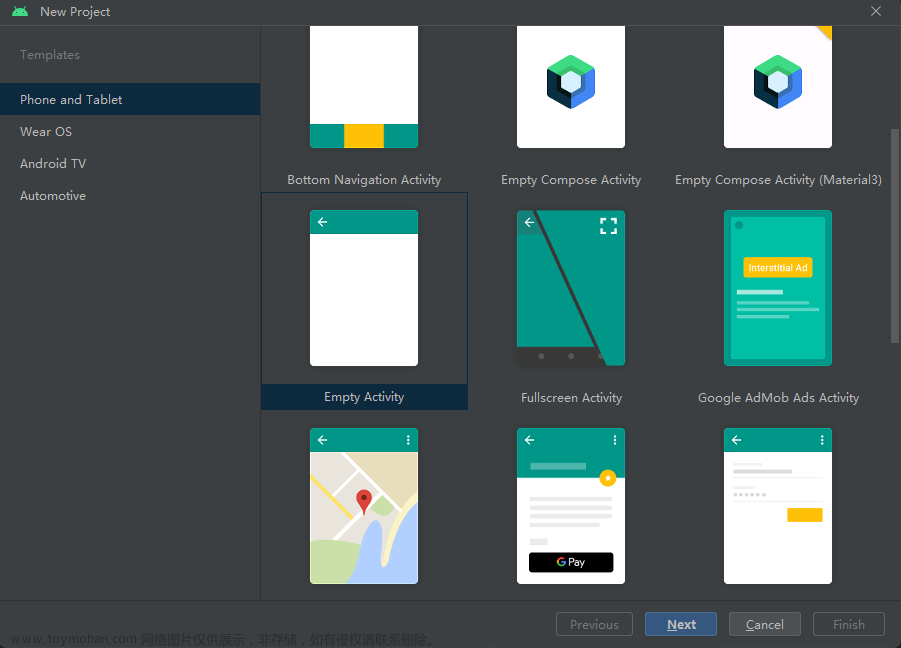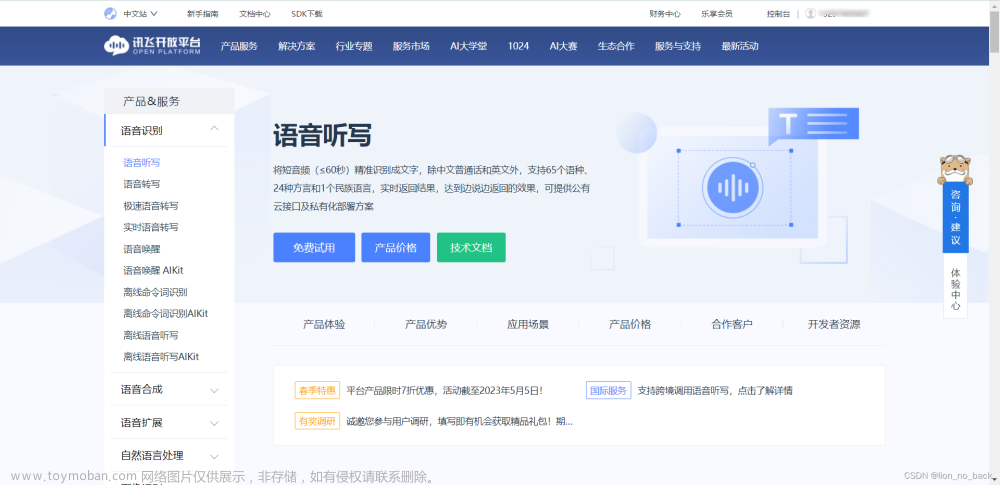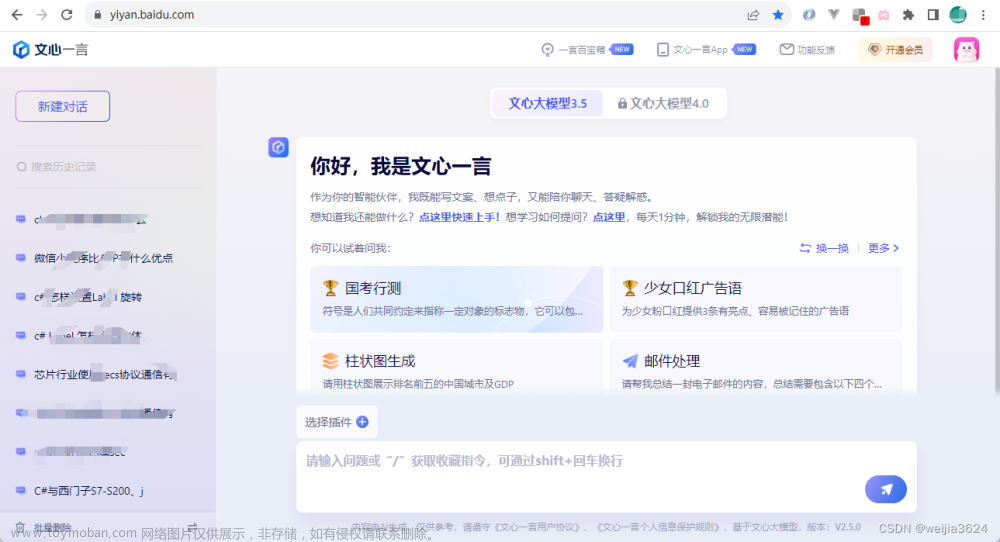Unity+讯飞语音+讯飞星火+Motionverse打造智能数字人
不废话,先来效果视频
unity+讯飞语音识别+讯飞星火大模型+Motionver
然后说说原理
要实现这个,主要的实现三个模块的接入:
- 语音识别。作用是吧麦克风的语音转化为gpt大模型能够识别的文字。然后发给gpt。
- GPT大模型。作用当然是把第一步中生成的问题文字转换为解答文本。
- 数字人驱动。作用使用文字内容,驱动数字人的动作,并生成语音进行播报。
下面说说具体的接入步骤以及遇到的坑,还有解决方案
一、接入讯飞语音
这个是三个模块中接入最顺利的了。
开通的方法很简单,去讯飞开放平台,注册一个账号,创建好应用,领取一下新人福利,就能获取50000多的服务量,这个对于开发测试而言绝对管够了。具体方法不涉及技术问题,这里不再赘述。
这里涉及两个问题:
- 如何自动录音。我的方法是,麦克风其实一直都在录音,但是我会监听麦克风一段时间内的平均音量,当达到阈值,就记录下这个时间点(为了录音完整,再减去一点点时间)作为开始记录点,然后当平均音量低于某个阈值,并且保持了一段时间的低音量,就记录这个时间点作为结束点,截取开始和结束点的录音,这样就由了语音了,使用有穷自动状态机来实现上面的逻辑,清晰明了。
算法代码如下:
public event OnAudioToTextConvertedHandler OnAudioToTextConverted; // 语音转为文字成功事件
public event OnRecordStartedHandler OnRecordStarted; // 开始录制事件
public event OnRecordStopedHandler OnRecordStoped; // 停止录制事件
private enum State // 状态机三种状态
{
Listening, // 监听状态,没有录音
Recording, // 正在录音
PreStop // 准备停止录音
}
// 初始状态处于监听状态
private State state = State.Listening;
private void Update()
{
volume = GetVolume(); // 获取平均音量
switch (state)
{
case State.Listening: // 处于监听状态时,音量大于阈值,就开始录音
if (volume > BeginRecordThreshold)
{
state = State.Recording;
startPos = Microphone.GetPosition(null) - 2000;
// OnStartRecord;
OnRecordStarted?.Invoke();
}
break;
case State.Recording: // 处于录音状态时,音量小于阈值,就准备停止
if (volume < StopRecordThreshold)
{
state = State.PreStop;
waitTime = 0;
}
break;
case State.PreStop: // 处于准备停止状态时,超过时间,就真的停止
if (volume < StopRecordThreshold)
{
if (waitTime > StopWaitTime)
{
var end = Microphone.GetPosition(null);
XunFeiMSC.AudioToText( clip.ToBytes(startPos, end ));
state = State.Listening;
// OnStopRecord;
OnRecordStoped?.Invoke();
}
else
waitTime += Time.deltaTime;
}
else
state = State.Recording;
break;
}
}
private float GetVolume()
{
if (Microphone.IsRecording(null))
{
var offset = Microphone.GetPosition(null) - ( TestDataLength + 1 );
if (offset < 0)
return 0;
clip.GetData(datas, offset);
float av = datas.Sum() / datas.Length;
return Mathf.Max(0, av);
}
return 0;
}
- C# 如何接入讯飞语音SDK
这的确是个不太友好的SDK,因为他只支持C/C++,你要再unity中用,那家伙,得一顿研究:第一,你得研究你到底用到哪些API,然后查头文件,看他们的定义,将他们从DLL中引入。第二,从C/C++的DLL里引入并不是很轻松的事情,因为有很多参数,你得转换为C#的,这就涉及类型对应的问题,没办法,问GTP4、Google搜。。不过,我这里提供一下已经整理好的:
namespace HexuXunFeiMSC
{
public static class XunFeiMSC
{
[DllImport("msc_x64", CallingConvention = CallingConvention.StdCall)]
public static extern int MSPLogin(string usr, string pwd, string parameters);
[DllImport("msc_x64", CallingConvention = CallingConvention.StdCall)]
public static extern int MSPLogout();
[DllImport("msc_x64", CallingConvention = CallingConvention.StdCall)]
public static extern IntPtr MSPUploadData(string dataName, IntPtr data, uint dataLen, string _params,
ref int errorCode);
[DllImport("msc_x64", CallingConvention = CallingConvention.StdCall)]
public static extern int MSPAppendData(IntPtr data, uint dataLen, uint dataStatus);
[DllImport("msc_x64", CallingConvention = CallingConvention.StdCall)]
public static extern IntPtr MSPDownloadData(string _params, ref uint dataLen, ref int errorCode);
[DllImport("msc_x64", CallingConvention = CallingConvention.StdCall)]
public static extern int MSPSetParam(string paramName, string paramValue);
[DllImport("msc_x64", CallingConvention = CallingConvention.StdCall)]
public static extern int MSPGetParam(string paramName, ref byte[] paramValue, ref uint valueLen);
[DllImport("msc_x64", CallingConvention = CallingConvention.StdCall)]
public static extern IntPtr MSPGetVersion(string verName, ref int errorCode);
[DllImport("msc_x64", CallingConvention = CallingConvention.StdCall)]
public static extern IntPtr QISRSessionBegin(string grammarList, string _params, ref int errorCode);
[DllImport("msc_x64", CallingConvention = CallingConvention.StdCall)]
public static extern int QISRAudioWrite(IntPtr sessionID, byte[] waveData, uint waveLen,
AudioStatus audioStatus, ref EpStatus epStatus, ref RecogStatus recogStatus);
[DllImport("msc_x64", CallingConvention = CallingConvention.StdCall)]
public static extern IntPtr QISRGetResult(IntPtr sessionID, ref RecogStatus rsltStatus, int waitTime,
ref int errorCode);
[DllImport("msc_x64", CallingConvention = CallingConvention.StdCall)]
public static extern int QISRSessionEnd(IntPtr sessionID, string hints);
[DllImport("msc_x64", CallingConvention = CallingConvention.StdCall)]
public static extern int QISRGetParam(string sessionID, string paramName, ref byte[] paramValue,
ref uint valueLen);
[DllImport("msc_x64", CallingConvention = CallingConvention.StdCall)]
public static extern IntPtr QTTSSessionBegin(string _params, ref int errorCode);
[DllImport("msc_x64", CallingConvention = CallingConvention.StdCall)]
public static extern int QTTSTextPut(IntPtr sessionID, string textString, uint textLen, string _params);
[DllImport("msc_x64", CallingConvention = CallingConvention.StdCall)]
public static extern IntPtr QTTSAudioGet(IntPtr sessionID, ref uint audioLen, ref SynthStatus synthStatus,
ref int errorCode);
[DllImport("msc_x64", CallingConvention = CallingConvention.StdCall)]
public static extern IntPtr QTTSAudioInfo(IntPtr sessionID);
[DllImport("msc_x64", CallingConvention = CallingConvention.StdCall)]
public static extern int QTTSSessionEnd(IntPtr sessionID, string hints);
[DllImport("msc_x64", CallingConvention = CallingConvention.StdCall)]
public static extern int QTTSSetParam(IntPtr sessionID, string paramName, byte[] paramValue);
[DllImport("msc_x64", CallingConvention = CallingConvention.StdCall)]
public static extern int QTTSGetParam(IntPtr sessionID, string paramName, ref byte[] paramValue,
ref uint valueLen);
}
}
然后就是发送录音并获取转换好的文本了:
// 这里是多线程版本,这个函数将在非主线程运行
private static void RealQueryAudioToText(object obj)
{
try
{
byte[] data = (byte[])obj;
// 首先登录讯飞平台
int res = MSPLogin(null, null, appId);
if (res != 0)
throw new Exception($"Can't Login {res}");
// 获取会话ID
IntPtr sessionID = QISRSessionBegin(null, sessionBeginParams, ref res);
if (res != 0)
throw new Exception($"SessionBegin Error {res}");
EpStatus epStatus = EpStatus.MSP_EP_LOOKING_FOR_SPEECH;
RecogStatus recognizeStatus = RecogStatus.MSP_REC_STATUS_SUCCESS;
// 发送语音数据,并标明这是最后一段(表示这句话完整了,后续没有别的录音了)
res = QISRAudioWrite(sessionID, data, (uint)data.Length, AudioStatus.MSP_AUDIO_SAMPLE_LAST, ref epStatus, ref recognizeStatus);
if (res != 0)
throw new Exception($"Write failed {res}");
StringBuilder sb = new StringBuilder();
// 获取结果,直到结束
while (recognizeStatus != RecogStatus.MSP_REC_STATUS_COMPLETE)
{
IntPtr curtRslt = QISRGetResult(sessionID, ref recognizeStatus, 0, ref res);
if (res != 0)
throw new Exception($"get result failed. error code: {res}");
sb.Append(Marshal.PtrToStringUTF8(curtRslt));
}
// 会话结束
res = QISRSessionEnd(sessionID, "Finish");
if (res != 0)
throw new Exception($"end failed. error code: {res}");
// 退出登录
res = MSPLogout();
if (res != 0)
throw new Exception($"logout failed. error code {res}");
// 结果回调
OnAudioToText?.Invoke(sb.ToString());
}
catch (Exception e)
{
OnError?.Invoke(e.Message);
}
}
二、接入讯飞星火大模型
这个需要在讯飞控制台提前申请,不过很容易就能通过,但是需要等待一天左右。通过后,他会给你50万的Token数,Token类似于“单词”,平均起来,一句话基本上会消耗几十到几百个Token,50W也够测的了。
这里遇到了很多坑。
本来想继续用它提供的SDK,但是一看又是只有C/C++的,鉴于前面语音识别时DLL引入到C#的痛苦,有点动摇,但它还提供Web访问,果断选择Web,没想到Web也遇到了一堆问题。
按照它给的Python案例,按照自己的理解,用C#重写了一下,信心满满的去测试,没想到无论怎么测,都失败。先是用UnityWebRequest去请求,失败,以为是UnityWebRequest不支持WSS协议,换成了HttpWebRequest,还是失败,最后用WebSocket重写了请求逻辑,仍旧失败。。我靠,只好静下心来看之前发请求之前的代码,最终发现在生成鉴权URL时,C#生成的url比它Python案例中生成的少了几个字节,然而并没有发现原因,很是莫名其妙,仔细对比了下,发现少的几个字节,用于都是AI==四个字符,而且是固定的,我去。直接写进去算求,没想到就解决了。至于UnityWebRequest、HttpWebRequest是否此原因导致的,已经不想再去重测了。下面给出代码:
// 生成鉴权URL
private static string BuildURL()
{
Uri uri = new Uri(gptUrl);
string host = uri.Host;
string date = DateTime.UtcNow.ToString("R");
var auth = $"host: {host}\ndate: {date}\nGET {uri.PathAndQuery} HTTP/1.1";
var sha256 = HmacSha256(auth, apiSecret);
var signature = Convert.ToBase64String(sha256);
string authorizationOrigin =
$"api_key=\"{apiKey}\", algorithm=\"hmac-sha256\", headers=\"host date request-line\", signature=\"{signature}\"";
string authorization = Convert.ToBase64String(Encoding.UTF8.GetBytes(authorizationOrigin));
return gptUrl + "?authorization=" + authorization + UnityWebRequest.EscapeURL("IA==") + "&date=" +
UnityWebRequest.EscapeURL(date) + "&host=" + UnityWebRequest.EscapeURL(host);
}
// 发起问题请求,这也是多线程版本,此函数会在非主线程中调用
private static void RealRequestQuestion(object obj)
{
try
{
// 问新问题之前,把前面的问题也发过去,这样它才能联系上下文,它限制8Ktoken,所以只传前面20个问题
if (contentTextList.Count > 20)
contentTextList.RemoveAt(0);
contentTextList.Add(new QueryText() { role = "user", content = (string)obj });
// 生成鉴权URL,生成问题数据
string url = BuildURL();
string dataString = JsonConvert.SerializeObject(
new
{
header = new { app_id = appID },
parameter = new { chat = new { domain = "general" } },
payload = new
{
message = new
{
text = contentTextList.ToArray()
}
}
});
// 发起请求,写入问题,获取结果
using ClientWebSocket webSocket = new ClientWebSocket();
webSocket.Options.Proxy = null;
webSocket.ConnectAsync(new Uri(url), CancellationToken.None).Wait();
ArraySegment<byte> buffer = new ArraySegment<byte>(Encoding.UTF8.GetBytes(dataString));
webSocket.SendAsync(buffer, WebSocketMessageType.Binary, true, CancellationToken.None).Wait();
StringBuilder sbResult = new StringBuilder();
byte[] receiveBuffer = new byte [2048];
while (true)
{
WebSocketReceiveResult result = webSocket.ReceiveAsync(receiveBuffer, CancellationToken.None)
.GetAwaiter().GetResult();
string text = Encoding.UTF8.GetString(receiveBuffer, 0, result.Count);
if (string.IsNullOrEmpty(text))
{
break;
}
JObject res = JsonConvert.DeserializeObject<JObject>(text);
if (res == null)
{
break;
}
int code = (int)res["header"]?["code"];
if (code != 0)
{
break;
}
JObject choices = (JObject)res["payload"]?["choices"];
if (choices == null)
break;
int status = (int)choices["status"];
string content = (string)choices["text"]?[0]?["content"];
if(!string.IsNullOrEmpty(content))
sbResult.Append(content);
// 如果status不是2,表示回答还没有完成。
if (status == 2)
{
string answer = sbResult.ToString();
contentTextList.Add(new QueryText()
{
role = "assistant", content = answer
});
OnResponeQuestion?.Invoke(answer);
break;
}
}
}
catch
{
// ignored
}
}
三、接入Motionverse
这个可以说是整个里面最大的坑了。它提供的Unity插件,导入进去,在unity中运行没有问题,但是你想要打包,那就会报错。我的解决方法是:
// Packages\cn.deepscience.motionverse\Runtime\Interface\EngineInterface.cs
private const string DllName =
#if UNITY_EDITOR
"libMotionEngine";
#elif UNITY_IOS || UNITY_WEBGL
"__Internal";
#elif UNITY_ANDROID
"libMotionEngine";
#endif
// 改为:
private const string DllName = "libMotionEngine";
还有就是,即便是改了上面的代码,它也没法在2020以上版本的Unity中打包,只能用2020版本才可以打包成功。而且,这个Motionverse包引导导入,就会有一堆的警告,有的甚至是某些方法里面定义了从未使用的变量。我靠,这种低级问题也有。所以,可见Motionverse的代码质量并不高。
但是,它却是最易用的。只要绑定好了角色和骨骼,全程只需要调用一个函数:文章来源:https://www.toymoban.com/news/detail-664472.html
TextDrive.GetDrive(text);
总结
总体上来说,这个项目还有很多需要完善的地方,比如:文章来源地址https://www.toymoban.com/news/detail-664472.html
- 讯飞语音可以支持实时转换,就是说并不一定非得一句话说完,而是在说的过程中,就一直转换,并动态的修正,这样说完也就转换完了,效率比较高,但是我没有去深入研究实时转换和动态修正,这需要更好的耐心。
- Motionverse驱动效率比较低,每次都需要将文本发到后台,运算完成后,生成语音数据和动作数据,再发回来,延时比较大,动作驱动比较生硬,而且从idle动画转到说话时的动作,没有过度,很不友好。
到了这里,关于Unity+讯飞语音+讯飞星火+Motionverse打造智能数字人的文章就介绍完了。如果您还想了解更多内容,请在右上角搜索TOY模板网以前的文章或继续浏览下面的相关文章,希望大家以后多多支持TOY模板网!







![常见大模型对比[ChatGPT(智能聊天机器人)、Newbing(必应)、Bard(巴德)、讯飞星火认知大模型(SparkDesk)、ChatGLM-6B]](https://imgs.yssmx.com/Uploads/2024/02/503469-1.png)






